Touring the Telescope
Bob set me up with a tour of the South Pole Telescope (SPT), which lies a short distance from the South Pole Station. Luckily, there was an available shuttle van so we didn't have to walk! As we drove towards the South Pole Telescope, the large base of the telescope was visible. Inside the building that houses the SPT, we met Brad who gave us a tour of the telescope.
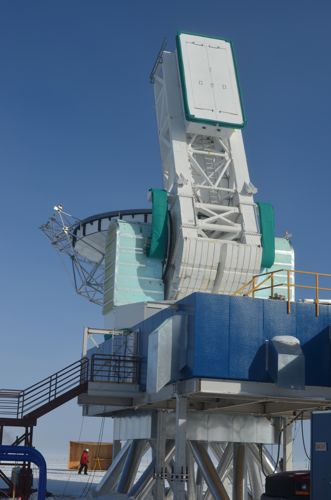
What is the SPT looking for?
Brad explained that the SPT is trying to discover how the universe began. By doing this, it hopes to find clues that explain why galaxies are spinning faster than we expect (which scientists attribute to dark matter and dark energy). Brad told us that only 5% of the universe is composed of matter that we are familiar with. The remaining 95% of the composition of the universe is a mystery to us, composed of what we call dark energy and dark matter. The telescope is trying to capture light that was emitted before galaxies and stars even formed. To do this, the SPT looks at microwaves. Microwaves have a relatively low wavelength, as you can see from the picture below.
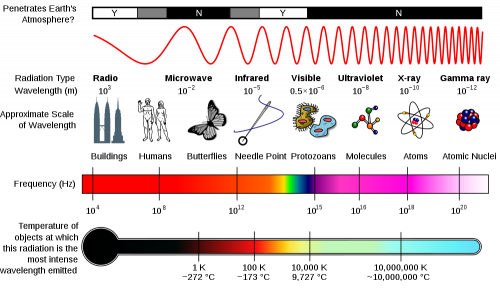
The telescope is measuring the cosmic microwave background (CMB) of the universe. The current theory is that CMB radiation is left over from when the universe fist began. Before stars and galaxies formed, scientists theorize that the universe was much smaller and composed of dense, hot, hydrogen plasma. This hot plasma emitted (gave off) energy such as light. The light traveled outwards from the plasma uniformly, which today is seen as a background glow that cannot be followed back to any one star or galaxy. However, the light that was emitted when this early universe began is no longer a light wave, but has changed to a microwave as it has lost energy and grown weaker. The South Pole Telescope has been able to detect this background to create a picture of the universe 14 billion years ago. How old was the universe at 14 billion years ago? Think of it this way: if the universe is 100 years old today, then it would have been 8 minutes old in the picture below.
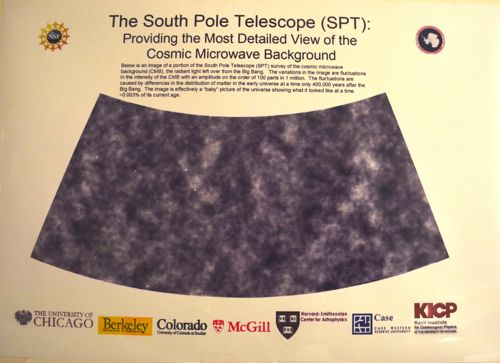
How does the telescope work?
The telescope has a large dish, however the cosmic microwaves are recorded on tiny silicon chips, similar to computer chips. These chips have 1,552 detectors that are sensitive to the heat from microwaves, much like how a camera has sensors that are sensitive to light. Each silicon chip in the telescope is 4 mm wide and 10 nanometers thick. 10 nanometers is extremely thin! To give you a sense of that, a helium atom is 0.1 nanometers and a ribosome (a small organelle in our cells) is 20 nanometers wide!
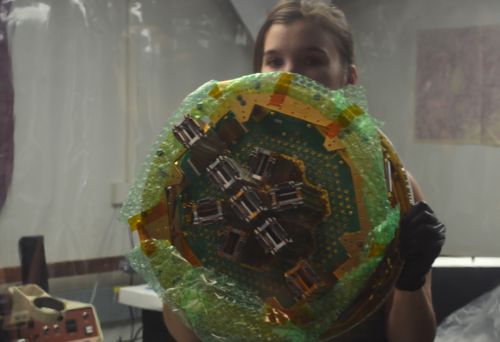
Webs of plastic covered with copper cover the microchips. This helps filters out light, which is a wavelength that the SPT is not trying to record. The chips sit at the bottom of cones, which refocus the microwaves towards the chips. Another important step to getting the best data is to keep the chips cold. The colder the chips are, the more sensitive to heat (and therefore cosmic microwaves) they are. The chips are kept at 0.25 degrees above absolute zero, which is very cold. Absolute zero is a theoretical temperature at which atoms do not vibrate. It is measured in Kelvin, not Fahrenheit or Celsius. 1 degree Kelvin is the same as -458 degrees Fahrenheit! To get the chips that cold, the scientists use pressurized helium. The helium can get as cold as 4 degrees Kelvin, and if it is pumped, it can get to 1.2 degrees Kelvin. Being at the South Pole probably doesn't hurt either!
It's a big telescope!
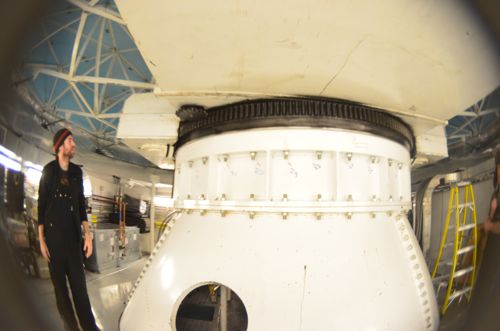
Although the sensors for the telescope are small, the rest of the telescope is quite large! The telescope is 400,000 pounds and rotates on 200 rolling cylinders. A few years ago, the scientists discovered that one of the cylinders was placed at the wrong angle (90 degrees off), and was being scraped around inside the telescope. They were able to raise the 400,000 pound telescope 4 feet to fix the problem, but only with the help of some pretty tough machinery!
Why is SPT at the South Pole?
The South Pole is a great place for the SPT because the microwaves it is trying to detect are absorbed by water vapor. The South Pole is one of the driest places on Earth, which means less water vapor. Also, the South Pole is very high and has a thin atmosphere which often gets in the way of the microwaves.
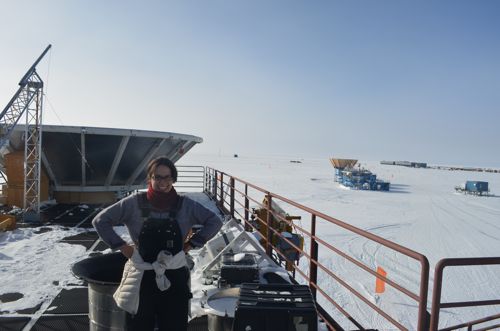
Learn more about the SPT!
You can learn more about the South Pole Telescope from their blog at: https://pole.uchicago.edu/blog/
Questions
On our tour, someone asked Brad whether they were interested in putting a telescope up in outer space to look at the cosmic background and better understand the early universe. Brad said no, they prefer working on the ground. What are some benefits of having a telescope on the ground rather than in outer space? What are some benefits of having a telescope in outer space?
Math Connection
The chips on the SPT are 10 nanometers thick. If the diameter of a helium atom is 0.1 nanometer, how many helium atoms would fit across the height of the chip?
The Helium used to cool the sensors of the SPT is getting expensive! 1 liter of Helium used to cost 1 or 2 dollars. Now 1 liter of Helium costs $20. How much would 15 liters of Helium cost today? How much would it have cost in the past?
If 400,000 lbs of telescope rest on 200 bearings, how much weight is each bearing supporting?

Comments